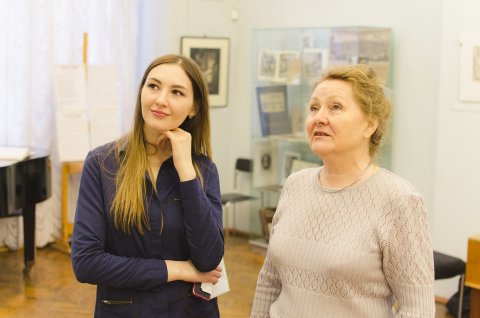Not too long ago a poll was held at SUSU in which the university’s international students participated. They chose the most interesting place in the university. In their opinion, it’s the SUSU Museum of Art. This is not surprising, as exhibitions of classical art from the country and region’s museums, modern and, of course, unique personal exhibitions, have been held here for almost 14 years. They bring students, professors, humanitarian and technical specialists, experts, and the university’s guests together in dialogue.

The museum’s collection contains unique exhibits: the personal collections of our region’s masters, artists of different generations, and representatives of 20th century art. All of this is reflected in the works presented at the museum’s exhibition space. Among them are absolutely unmistakable works which were gifted from one artist to another, holding deep meaning because of this connection. All of these valuable objects were given to the university’s Museum of Art by the masters themselves, their families, art historians, or were donated by the Chelyabinsk organization, the Union of Russian Artists.
The 121st exhibition, The art of graphics: from drawing to engraving, will introduce visitors to one of the most important principles and methods of informational evolution and its instrumental materialization in cultural history – the art of engraving. The development of modern printing is inconceivable without humanity’s mastery of this type of art. The exhibition will introduce the process of creating an engraving, which is usually hidden from the view – from graphite pencil sketches, printing blocks, and proofs to the final works, which are presented with all the variety and wealth of graphic art.

The surprising world of engraving is opened for the university viewer by Galina Trifonova, museum director, researcher of regional art, art historian. She shared some surprising facts about the museum’s masterpieces.
“The museum of art is part of the university’s structure, so our exhibits must help students’ academic and educational process. The exhibits open a new plane of the artistic process, acquaint viewers with interesting occurrences in art, and all of this is based in the science of art history. The leading character is regional art. This is not a narrow local, small-town, or provincial understanding. The Ural region is a territory of two thousand kilometers from north to south. Here there are many cultural centers; there is a large and rich history of art. There are really many virgin horizons that are now being studied by representatives of different sciences and areas,” - says Galina Semenovna.
Regional art is represented in the exhibition by works of masters which were previously well known across the country. Their art can be found in the Russian Museum and Tretykov Gallery – these are the works of Valentina Chelintsova and Mikhail Tkachev. The “three whales” of South Ural region engravings are Nikolai Cherkasov, Vladimir Bubnov, and Nikolai Tretyakov. Among masters of the older generation, the exhibit presents the works of painter Viktor Merkulov, pencil artist Nikolai Kudrichev, and graphic artist Vasiliy Yarantsev.
“Students who complete internships in the museum’s archives encounter authentic artworks every day one-on-one, and this contact is of the greatest importance to forming the perspective of a future professional art historian,” - says Galina Trifonova.

Ural masters participated in the development of graphic arts and engraving alongside artists from the capital. In their works we see nature, objects, and man through the artist’s perspective, through his era, his feelings.
“This is a sketch by Kudrichev,” explains Galina Semyonova, “look how easily, but completely accurately, the landscape is shown! Literally with a few strokes. In engraving, this accuracy is especially important: if you made a mistake, you’ve ruined it.”
Every work has its character, history, and individuality. For example, the motive of pine trees in the series of works of one artist, N. I. Cherkasov, shows the process of artistic exploration. In the first we see a roaring intensity, contrasting colors; in the second – lighter colors, more natural, forming the feeling of dusk. Here we see the harsh Ural pine and the triumphant pine in Crimea on the sea shore. The Ural pine symbolizes strength and battle, the second – fragrance, harmony.
.jpg)
The historian said that creating an exhibition is not a simple task – it is a process which requires multi-faceted knowledge and a great amount of professionalism, needing a lot of energy and time.
“An idea, acute to a given time and space, is the key to the basis of a future exhibit. In art, all works are unique, one-of-a-kind – if it is really art! Sometimes it is difficult to make a choice, to see and understand a work in its fullness, when they are laying on a table or in a folder; it’s difficult to view it when it’s in front of you on a flat plane. It’s a different matter when the work, as a result of a carefully chosen composition, finds its place on the wall and takes on its location within the space and idea of the exhibit. Here is where it really opens up most of all.”
The organizers pay attention to the exhibit’s overall character and each of its details: logic, a convincing progression in the works’ placement, rhythm, dynamics, accents, decorative decisions and much more are all important, depending on the concept of a specific exhibition.
Artists experiment, search for new instruments and methods of materializing their inner world in graphic works of various types and methods of creation. Therefore, artists often move outside of the boundaries of academic drawing, from the format of a genre, and hold experiments. For example, in his engravings, Nikolai Tretyakov combined bronze and copper powders in the inks for printing.
“Long before our contemporary, this was done by Rembrandt, who added glass powder to his inks to strengthen the reflection of color in his paintings. Our artist uses metal powders, which gives the prints an exceptional effect,” - comments Galina Semyonovna.

Many artists dedicated their lives to not just art, but also to the industrial development of the city. For example, N.I. Cherkasov, member of the Union of Artists, worked in the ChTZ all of his life, and on the weekend he worked on new creations. His prints reflect his view on life, the life of a factory worker and artist.
“His industrial landscapes are organized, logical. They are full of reason, wisdom, and beauty. But besides all of that, we see here rays of sunshine through the clouds and, of course, man. The scale of the human figures is small alongsize the magnitude of industry – but this is the meaning of N.I. Cherkasov’s engravings on industrial topics: man is small, but the world built according to his design and his work is huge, harsh, logical, and beautiful, in harmony with nature.”
Through the prints presented in the SUSU Museum of Art’s exhibitions, the majority of its collection goes through full historical eras and the fates of real people, their worries, their love and belief.
“Every artist has the fate to write a novel,” - notes Galina Semyonovna.
Each piece of art has its own meaning and is not limited by the accuracy of depiction and aesthetic components. It may seem that in a simple still-life that the sun and sky are reflected by things. In engraving interiors and indoor plants you can hear a dialogue among objects. Galina Trifonova says that for an artist, a still-life is a unique genre – its conventional language helps the artist speak about everything on the planet, but to see and understand this, you must love all of it.
.jpg)
According to the art historian, the technological nature of the modern world creates the threat of separation from authentic art. The internet allows us to see everything thus far created in art, but we need not delude ourselves – we are not looking at the original but through the prism of the screen, in effect, a reproduction. It is not important if it is static or dynamic.
“The original has a specific energy which leaves it as a result of its mechanical duplication – a counterweight to printing in engraving – always thought-out and artistic. The original artwork is so unrepeatable and unique in its existence – like any given human. In each masterpiece there is an unrepeatable grain of individuality,” - says the museum director.
The SUSU Museum of Art brings artistic thought and creativity to the university environment. According to the museum director, the proximity of art and technology is surprisingly advantageous and affects students harmoniously.
The exhibition organizers believe that a person who has been introduced to art in his university years will never leave art behind – it will always remain a part of his spirit. Art is an obvious spiritual need and necessity for the salvation, growth, and development of the human soul, and our era is not an exclusion. The natural growth of the soul is in university, where the future is born.
The exhibition lasts until May 18th – the International Day of Museums. Entry to the Art Hall, where it is shown, is free.
Kseniya Mashkova, photo: Oleg Igoshin




